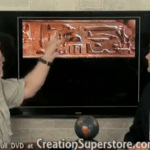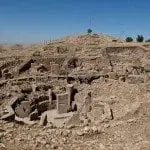
Since today is Columbus Day, I thought I would discuss a myth commonly associated with the man. I learned it in school, as did many others. It’s the myth that people in Columbus’s day thought the earth was flat. Highlights of American History Before 1850, for example, tells students about a conversation that supposedly took place between Christopher Columbus and Queen Isabella: (1)
“Your Highness,” said Columbus, “instead of going east across the land to reach India, your traders can sail west across the ocean.” “What? Are you mad?” asked Queen Isabella. “If they sail too far west they will fall off the edge of the earth!”
A more recent book puts it this way: (2)
Only 500 years ago, sailors aboard the Santa Maria begged Columbus to turn back lest they sail off the Earth’s “edge.”
There is a big problem with such pronouncements: no historical evidence exists to back up the idea that most people (even uneducated people) in Columbus’s day believed the earth was flat. In addition, there is a wealth of evidence that indicates no one took such an idea seriously.
We know, for example, that philosophers understood the spherical shape of the earth long before Christ was born. It was discussed by philosophers like Pythagoras in the fifth century BC (3) and became widely accepted when it was championed by Aristotle (384–322 BC). He saw that the stars were different in one part of the world than the other. This indicated to him that the earth must be a sphere. (4) The spherical shape of the earth was so widely accepted among philosophers that Eratosthenes (c.276–c.195 BC) used the change in a staff’s shadow resulting from a 500-mile trip to measure the circumference of the earth. He was correct to within less than 2% of today’s accepted value. (5)
But wait a minute. Didn’t the early church teach that the earth is flat? Absolutely not. The earliest voice in Christendom who mentions the shape of the earth is Clement of Alexandria (AD 150-215), and he wrote: (6)
And how the Earth and sea their place should keep; And when the seasons, in their circling course, winter and summer, spring and autumn, each should come, according to well ordered plan; out of a confused heap who didst create this ordered sphere, and from the shapeless mass.
I can’t find any early Christian writer who even suggested that the earth was flat. Why do people think the church taught a flat earth? According to historian Dr. James Hannam: (7)
The myth that a flat earth was part of Christian doctrine in the Middle Ages appears to have originated with Sir Francis Bacon (1561–1626), who wrongly claimed that geographers had been put on trial for impiety after asserting the contrary.
So the church never taught a flat earth, and educated people since the third century BC knew the spherical shape of the earth. Even uneducated sailors understood that the earth must be a sphere, because they knew you that the higher you got above sea level, the farther away you could see the ships that were at sail. Why, then, did Columbus have trouble getting support for his ambitious idea to sail around the world to reach India? Because thanks to Eratosthenes in the second century BC, educated people knew how far he would have to sail to complete the trip, and they didn’t believe such a voyage could be made!
But who originated the idea that people thought Columbus would sail off the edge of the earth? It seems to have come from Washington Irving, the fiction author who wrote “The Legend of Sleepy Hollow.” In 1828, he wrote a novel of historical fiction entitled, A History of the Life and Voyages of Christopher Columbus. Apparently, he read an account of the meeting between Columbus and Queen Isabella that was written 130 years after Columbus set sail. He embellished it, and ended up producing a scene in which a “university council” argued that the earth was flat and Columbus would sail off its edge. Samuel Eliot Morison (a historian and distinguished naval officer) evaluates Irving’s work as follows: (8)
The whole story is misleading and mischievous nonsense…The sphericity of the globe was not in question. The issue was the width of the ocean; and therein, the opposition was right.
On this Columbus day (or any other day), when you hear someone say that ancient people (or the church) thought the earth was flat, please set them straight. Lies need to be debunked, especially ones that are taught to us in school!
REFERENCES
1. Joel Legunn, Highlights of American History Before 1850, Prentice Hall School Group, 1979, p. 9
2. Geology Super Review, Carl Fuchs, chief editor, Research and Education Association, 2003, p. 1
3. Diogenes Laertius, The Lives and Opinions of Eminent Philosophers, George Bell and Sons, 1901, p. 358
4. Antonis Modinos, From Aristotle to Schrödinger: The Curiosity of Physics, Springer 2014, p. 16
5. Art Johnson, Famous Problems and Their Mathematicians, Teacher Ideas Press, 1999, p. 87
6. Saint Clement (of Alexandria), The Writings of Clement of Alexandria, William Wilson (translator), T. &T. Clark, 1884, p. 346
7. James Hannam, The Genesis of Science, Regnery Publishing, 2011, p. 28
8. Richard F. Hamilton, The Social Misconstruction of Reality: Validity and Verification in the Scholarly Community, Yale University Press, 1996, p. 18







